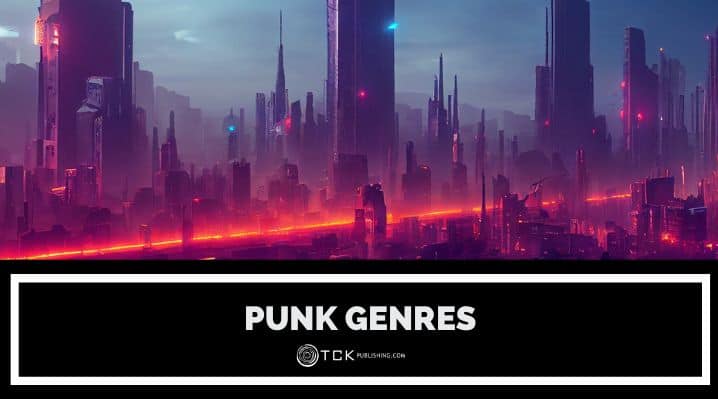
When you talk about “punk” in literature and other media, you usually think about cyberpunk and steampunk. They’re two of the most popular punk genres that exist, but hardly the only ones you can read.
Over the years, writers have created more niche types of punk fiction. Each one blends the rebellious, nihilistic spirit of punk counterculture with any other type of speculative fiction.
Punk Genres
We’ve already talked about cyberpunk and steampunk at length so they won’t make an appearance in this list. Check out these less popular types of punk fiction instead.
1. Biopunk
As its name suggests, biopunk speculates on a dystopian future overrun by the dangers of biotechnology and synthetic biology.
In this subgenre, you’ll find human experimentation, genetic engineering, eugenics, and totalitarian authorities who misuse biotechnology for profit and power.
A good example is the film Gattaca, where eugenics is common in a future society. A person’s value is judged by the quality of their genetics so parents “design” their children through genetic selection, guaranteeing that their kids get the best traits from both adults.
2. Clockpunk
Clockpunk portrays clockwork technology set in an era reminiscent of the Renaissance or Enlightenment. Think of it as steampunk without the steam, focusing instead on Da Vincian or gear-powered machinery.
One example is the book, Mainspring. The Earth is likened to a watch, whose mainspring (a metal ribbon that serves as the power source of a watch) is running down. Tasked by the archangel Gabriel, a clockmaker’s apprentice must make the dangerous journey to rewind it.
3. Atompunk
Atompunk draws heavily on the Atomic, Jet, and Space ages. It describes a retro-futuristic future (commonly during the Cold War) where technology is largely powered by nuclear energy.
The Fallout video game series is perhaps the most popular example of this subgenre, though it does take place in a post-apocalyptic setting instead of a dystopian one.
4. Cattlepunk
Cattlepunk is basically steampunk fiction that is set in the Wild West instead of the 19th century. In the rugged frontier, you’ll find cowboys firing steam-powered guns, automatons serving whiskey in saloons, and people riding airships.
The tv series The Wild Wild West is a good example of this. Though it identifies more as a blend of the Western and espionage genres, the use of advanced tech inspired by Jules Verne’s works made it end up as steampunk-ish.
5. Nanopunk
Nanopunk is similar to cyberpunk and biopunk but instead of cybernetics and biotechnology, it uses nanotechnology as its central motif. In this genre, nanotech is any technology that manipulates matter on a molecular or supramolecular scale.
Michael Crichton’s Prey is an example of this subgenre. A lab loses control of the nanobots they’re developing, which soon exhibit predatory behavior that endangers mankind.
6. Dieselpunk
Dieselpunk combines diesel-based technology with the aesthetics and cultural mindset of the 1920s-1950s. There’s a heavy sense of brewing war, gray morality, and fighting the impossible.
One curious element a lot of dieselpunk stories share is that the Great Depression never happened, replaced instead by economic and technological growth.
An example of dieselpunk is the movie, Sky Captain and the World of Tomorrow. In an alternate 1930s, the leader of a private air force fights against a mad scientist who uses giant robots, gynoids, and other futuristic tech to bring about a “reset” of the world.
7. Stonepunk
Stonepunk is what you get when you take the Stone Age, let it advance technologically….but never actually evolve into a new era.
Here, you’ll get materials that are in line with the era but used in anachronistic complexity. Just think of The Flintstones and their bird-powered typewriter, dinosaur lawnmower, and stone furniture.
A more recent example is the manga, Dr. Stone. A teenage genius finds himself in the far future, where the world has been reset into the Stone Age. To survive, he uses his intellect to create modern materials and machines.
8. Solarpunk
Think of solarpunk as the opposite of cyberpunk. Instead of a nihilistic future riddled with societal collapse and technological abuse, you get an optimistic future with tight-knit communities and renewable energy. Think of it as a revolt against the despair of most other punk genres.
The “punk” element comes in the form of subverting the systems that prevent this future from happening. Resource exploitation, corporate globalization, and industrialization are then replaced by sustainable living, a focus on local communities, and artisan work.
An example is the Monk and Robot duology. A moon called Panga is converted into a completely sustainable and pollution-free haven where everyone’s needs and wants are fulfilled. Robots have faded into myth until one emerges from the wilderness and asks a traveling monk “What do humans need?”
9. Elfpunk
Elfpunk is different from other punk derivatives as its main theme is common and traditional fantasy creatures instead of technology. Think of it as urban fantasy with a particular focus on elves, faeries, dwarves, trolls, and dragons.
Netflix’s Bright is an example of this. In a world where humans and mythical creatures co-exist, an LAPD cop and his orc partner must fight against racism and corruption.
10. Dungeonpunk
Dungeonpunk is where magic and technology meet. It takes the grittiness and darkness of cyberpunk and puts it into a fantasy setting.
Instead of airplanes, you get magical skyships. Instead of coal, trains use bound elementals to generate power. And instead of gunpowder, you get aether-powered firearms instead. Think of it as “sciency” magic, where there’s a technical aspect to how magic is generated and employed.
Not all Magitech falls into this genre, however. There still needs to be an element of cynicism and nihilism to signify the “punk”.
The Eberron campaign setting for Dungeons & Dragons fits perfectly into this genre. One of its predominant species is the Warforged, a race of magitech robots trying to find a new purpose after outliving the war they were created for.
What is Punk Fiction?
Punk fiction is any fiction that blends elements of the punk counterculture with other elements. It was kickstarted by the cyberpunk genre, which explored a future where cybernetics and artificial intelligence were juxtaposed with societal collapse and dystopia.
Its popularity soon made way for various derivatives, which didn’t necessarily share the mechanical and digitally focused worlds of cyberpunk. The most popular, steampunk, displayed steam technology in a setting reminiscent of the Victorian and Elizabethan eras.
One thing that most of these derivatives share is a focus on a certain technology that is heightened to an extreme level, even when it is made to be fantastical or anachronistic to the setting.
And of course, each one of them features the attitude, aesthetics, and sensibilities of punk. Themes of social inequality, oppression, rebellion, individualism, and unconventional thinking are frequently used.
There are a lot more types of punk out there that you can read. The ones included in this list are just a few of the better-defined ones.
What are your favorite types of punk fiction? Share them in the comments below!
If you enjoyed this post, then you might also like:
- 8 Cyberpunk Tropes that Embody the Genre
- 15 Splatterpunk Books for When You Need Hardcore Scares
- Steampunk Books: Your Guide to the Retrofuture
- What Is a Zine?

Cole is a blog writer and aspiring novelist. He has a degree in Communications and is an advocate of media and information literacy and responsible media practices. Aside from his interest in technology, crafts, and food, he’s also your typical science fiction and fantasy junkie, spending most of his free time reading through an ever-growing to-be-read list. It’s either that or procrastinating over actually writing his book. Wish him luck!
